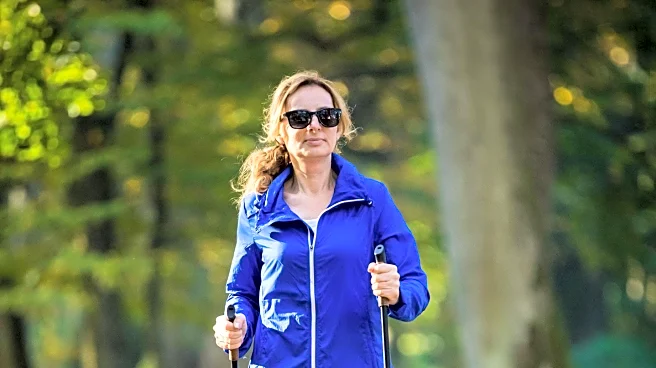What's Happening?
A recent study has examined the effects of Nordic walking and traditional strength training on muscle health in postmenopausal women. The research involved 71 healthy women aged 60-79, divided into three
groups: a high-intensity interval training (HIIT) Nordic walking group, a strength training group, and a control group with no exercise intervention. Over 12 weeks, both exercise groups showed significant improvements in muscle health markers, such as mobility, balance, and knee joint flexor strength. The study found that while both exercises are effective in preventing sarcopenia, each has unique benefits. Strength training improved walking speed, hand-grip strength, and reduced body fat mass, while Nordic walking enhanced limb lean mass and skeletal muscle index.
Why It's Important?
This study is significant as it provides insights into effective exercise strategies for postmenopausal women, a group at higher risk of sarcopenia. The findings suggest that both Nordic walking and strength training can help maintain muscle mass and function, which are crucial for reducing fall risk and improving overall health. The research highlights the importance of tailored exercise programs based on individual goals and body composition. For women aiming for sustainable weight loss, strength training may be more beneficial, while those focusing on muscle maintenance might prefer Nordic walking. This information can guide healthcare providers and fitness professionals in recommending appropriate exercise regimens.
What's Next?
The study suggests that postmenopausal women should consider incorporating both types of exercise into their routines for comprehensive muscle health benefits. Future research could explore the long-term effects of these exercises and their impact on other health outcomes. Additionally, fitness programs may increasingly integrate Nordic walking and strength training to cater to the needs of older women. As awareness grows, there may be a rise in community-based programs and resources to support these activities, encouraging more women to engage in regular physical activity.
Beyond the Headlines
The study underscores the broader implications of exercise in aging populations, particularly in addressing age-related muscle loss. It also highlights the potential for Nordic walking to gain popularity as a low-impact, full-body workout suitable for various fitness levels. The research may influence public health policies to promote diverse exercise options for older adults, emphasizing the role of physical activity in healthy aging. Furthermore, it could lead to increased investment in fitness infrastructure and programs tailored to the needs of postmenopausal women.











